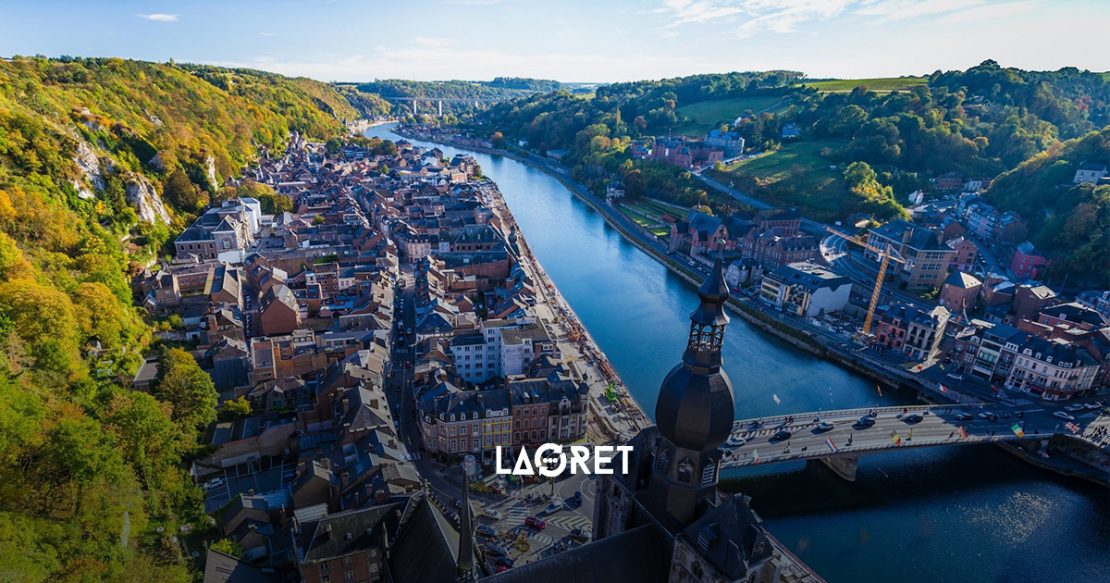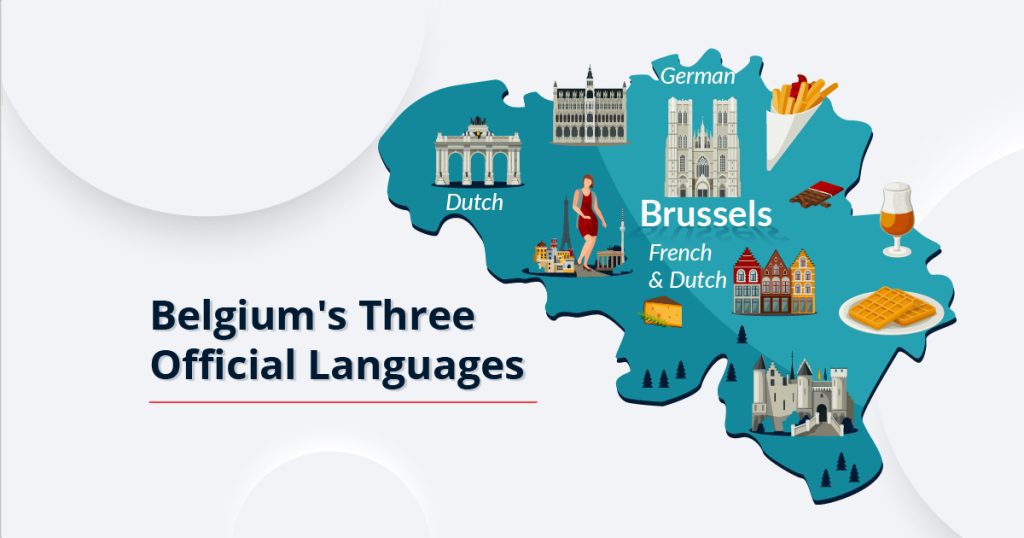Languages Spoken in Belgium: A Comprehensive Guide for Businesses
Belgium is a country situated at the heart of Europe and bordered by the Netherlands to the north, Germany to the east, Luxembourg to the southeast, and France to the southwest. So, what do you think this rich location brings to the table?
Of course, a multilingual country with remarkable linguistic diversity.
With three official languages, Dutch, French, and German, each holding significance in specific regions, Belgium’s linguistic landscape is really unique.
And the presence of regional dialects and minority languages further enriches it, making language an essential consideration for businesses operating in the country.
In this blog post, we will explore the diversity of languages Belgium holds and its history. In addition to providing you with actionable tips on how to succeed in this multilingual country as a business.
The Three Official Languages of Belgium
Exploring Dutch, French, and German in Belgium
1. Dutch:
Number of native speakers: 55% of the population
The first official language in Belgium and the most spoken language is Dutch. It dominates the northern region of Flanders, where it is often referred to as Flemish.
The linguistic richness of the region is enhanced by various Flemish dialects, including West Flemish, East Flemish, and Brabantian. These dialects add unique local flavors to the language.
Flemish, or Belgian Dutch, is closely related to the Dutch spoken in the Netherlands. While the core grammar remains the same, there are subtle differences in pronunciation, vocabulary, and idioms.
However, people who speak Dutch can generally find communication in Flanders quite manageable.
2. French:
Number of native speakers: 36% of the population
Second on the list of most spoken languages and one of the three official languages in Belgium is French. You’ll find French speakers primarily in two key areas, the southern region of Wallonia and the bustling capital, Brussels.
Now, you might be wondering, “Is Belgian French really that different from standard French?” Well, yes and no!
Again, the core is the same, but there are subtle differences in pronunciation and vocabulary. The differences in vocabulary and pronunciation between Belgian French and Standard French are distinct enough to warrant businesses using a translator based in Belgium for English-to-French translations aimed at the Belgian market.
They’ll catch nuances that might go unnoticed by someone accustomed only to standard French. It’s like having a local guide who knows all the secret pathways!
However, with a bit of change to the local accent, French learned in France is generally understandable in Belgium
3. German:
Number of native speakers: less than 1%
The German language is a minority language spoken in the eastern part of Belgium, particularly in the region bordering Germany. The presence of German speakers in Belgium can be traced back to historical territorial changes after World War I when several border areas were reassigned to Belgium.
As a result, a small German-speaking community became part of the Belgian population. Despite being a minority language, German holds official status in Belgium alongside French and Dutch.
Although the number of German speakers is relatively small compared to French and Dutch speakers, the language holds cultural and historical significance in the eastern region of Belgium.
Beyond the Official Languages: Regional Dialects and Minority Languages
Belgium’s linguistic landscape extends far beyond its three official languages, painting a rich landscape of regional dialects and minority languages. This diversity reflects the country’s complex history, cultural heritage, and modern multicultural society.
Let’s explore the lesser-known dialects that contribute to Belgium’s unique identity.
Romance Languages and Dialects:
In Wallonia, the French-speaking region, several legally recognized Romance languages and dialects add depth to the linguistic scene. These include:
- Walloon: The most widely spoken regional language, with variations across different parts of Wallonia.
- Picard: Found in western Wallonia, sharing similarities with dialects spoken in northern France.
- Champenois: Spoken in the southernmost part of the province of Namur.
- Lorrain: Used in the Gaume region, near the border with France and Luxembourg.
These dialects, while less commonly used in everyday life, are preserved through cultural associations and local initiatives.
Germanic Dialects:
Various Germanic dialects enrich Belgium’s linguistic diversity, particularly in the north and east:
- Limburgish: Spoken in the Limburg province, straddling the Belgian-Dutch border.
- Low Dietsch: Found in the northeastern part of the province of Liège.
- Luxembourgish: Used in some border areas with Luxembourg.
While not officially recognized, these dialects play a significant role in local identity and culture.
Immigrant Languages:
Belgium’s position as a multicultural hub has led to the presence of numerous immigrant languages, reflecting diverse communities from around the world.
Some of the more prominent ones include:
- Arabic: Spoken by communities from North Africa and the Middle East with 3%
- Turkish: Used by the Turkish immigrant community with 1% native speakers
- Italian: Reflecting historical migration from Italy with 2% native speakers
- Spanish and Portuguese: Spoken by communities from Southern Europe and Latin America the Spanish speakers are approximately 5%
- Polish: Used by more recent immigrants from Eastern Europe.
- English: Can’t be missed with 2% of the population speaking English as native speakers.
These languages contribute to Belgium’s vibrant multicultural atmosphere and are scattered across different parts of the country, especially in urban areas like Brussels, Antwerp, and Ghent.
This linguistic diversity not only enriches Belgium’s cultural landscape but also presents unique challenges and opportunities in education, social integration, and cultural preservation. It’s a testament to Belgium’s role as a crossroads of European cultures and its ongoing evolution as a multilingual, multicultural society.
The Linguistic Divide in Belgium
To understand why you hear so many languages spoken in Belgium today, we need to take a trip back in time and explore its past.
Over the centuries, Belgium has been like a crossroads for different cultures – Celts, Romans, Franks, Vikings – they all passed through, each leaving their own mark on the languages and traditions of the region.
Let’s dive in and see how this fascinating linguistic mix came to be!
| Period | Key Events and Influences |
| Roman Empire | Northern regions retained Germanic dialects; the south adopted Latin-based languages, laying the foundation for the Dutch-French divide. |
| Middle Ages | The County of Flanders maintained Germanic languages; southern areas, influenced by France, increasingly used French. |
| French Revolution | Napoleonic rule made French the official language, marginalizing Dutch in Flanders. |
| 1830 Independence | French was established as the sole official language, sparking resentment among Dutch speakers. |
| Late 19th Century | Rise of the Flemish Movement advocating for Dutch linguistic rights, leading to language laws in the early 20th century |
| 20th Century Economic Shift | Wallonia’s industrial dominance declined; Flanders grew economically, altering regional power dynamics and intensifying tensions |
| Brussels’ Bilingual Status | Originally Dutch-speaking, Brussels became predominantly French-speaking, creating tensions with surrounding Flemish regions |
| Present Day | The linguistic divide continues to influence politics, education, and social interactions in Belgium. |
This historical journey shows how Belgium’s linguistic divide is not merely about language, but a complex interplay of cultural, economic, and political factors. Understanding this history is crucial for grasping the nuances of Belgium’s current linguistic landscape and the challenges it faces in maintaining national unity while respecting linguistic diversity.
Succeeding in the Multilingual Belgian Market: A Localization Guide
Belgium’s linguistic diversity presents unique challenges and opportunities for businesses entering the market. This guide outlines key strategies for effective localization, ensuring your products or services resonate with Belgium’s multilingual audience.
Analyze Your Target Audience
When entering the Belgian market, it’s important to conduct thorough market research to understand language preferences across different regions.
As mentioned above, Belgium has three official languages, so if you are seeking the Flanders region which is predominantly Dutch-speaking, you can’t expect to communicate with them in the French language which is primarily spoken in the Wallonia and Brussels regions.
Additionally, immigrant languages like Arabic and Turkish are spoken in urban centers should be noted as well.
Analyzing demographic data can help identify language usage patterns among target customers, providing valuable insights for businesses to engage with diverse linguistic communities in Belgium.
So generally,
- Check which area you are targeting
- Check what the people are speaking in this area
- Translate and localize for the targeted areas accordingly
Choose Your Localization Approach
Evaluate your budget, timeline, and market penetration goals to determine the best strategy.
So you have to decide whether you need options like:
- Full translations that are ideal for nationwide campaigns or products.
- Partial translations that are suitable for region-specific marketing or phased entry
- Multilingual content production to create original content in multiple languages
After choosing your approach you can have a real picture of weighing costs and resources you need in addition to clear goals that you can manage if they are fulfilled yet or not.
Find Experienced Localization Partners
While a business seeking international countries like Belgium, you might think you can manage with simple translation for the three official languages. However, it’s crucial to seek out native Belgian translators who are intimately familiar with the country’s diverse regional language variations.
Also, consider partnering with translators who possess subject matter expertise in your specific industry to ensure the highest quality translations.
Additionally, don’t look for only translators, find seasoned localization providers adept at the Belgian market and catch the cultural nuance and deep historical influence in the country.
Working with localization agencies experienced in the Belgian market and cultural consultants will further guarantee authenticity in reaching your target audience.
Don’t miss out on this opportunity to expand your business with the right partners by your side!
Localize for Cultural Nuance
Localization experts will be aware of Belgian regional differences in humor, idioms, and cultural references as well as ensuring that visuals and imagery are culturally appropriate and relevant.
Also adapt content to reflect the Belgian market needs by paying attention to date formats, measurement units, and other locale-specific details. Ensure localized messaging resonates with target communities.
Offer Multilingual Marketing
Developing a multilingual website with language selection options is crucial when entering the Belgian market due to the country’s linguistic diversity. Creating marketing materials in Dutch, French, and potentially German will allow businesses to effectively reach and engage with the local population.
Providing customer support in multiple languages is essential for ensuring a positive and inclusive experience for all customers.
Moreover, establishing a multilingual social media presence will enable businesses to connect with diverse communities and build strong relationships. Adapting email marketing campaigns to language preferences demonstrates attentiveness to the needs and preferences of the target audience, ultimately contributing to successful market entry in Belgium.
In conclusion, Belgium’s linguistic diversity offers both challenges and opportunities for businesses. Understanding the intricate multilingual landscape and embracing localization strategies can significantly enhance your chances of success in this vibrant market.
But can you manage all these and more for the Belgium market? With a good language service provider, you can handle it all.
Laoret for Multilingual Solutions
For expert guidance on navigating the complexities of language in Belgium and to explore tailored localization solutions for your business, you will need Laoret.
Here at Laoret, we possess deep expertise in over 120 languages, making us well-equipped to assist you in the diverse and complex Belgium market.
Our deep understanding of Belgium’s unique linguistic divisions and cultural nuances enables us to provide tailored localization services for each region. We also hire native speakers who are experts in the field and keen to solve any language problems attentively.
By partnering with us, you ensure that your communications and products resonate authentically with Belgian customers, whether you’re targeting the Dutch-speaking or the multilingual population of Brussels.
Contact us now to discuss how we can help your business navigate and thrive in Belgium’s diverse linguistic market!






